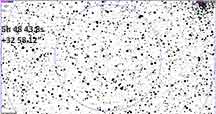The Occultation of a 13.8 star by Shen Guo
Mar 15, 2023 at 8:18:50pm PDT
This event is low rank, odds of a hit are only 21%. It's also tough; 83 degrees altitude at chart location time, 78 degrees at event time. This will require using the diagonal and 0.5x reducer to succeed. Also, the sun is only -13 degrees, so there won't be a lot of time to get this correct. Both charts below are flipped to assume the diagonal is in.

This chart assumes you're using the diagonal and 0.5x reducer. HOwever, the size of the square might not be perfect. It's just the usual f/3.3 reducer size'd square |

Eyepiece view. The rich cluster at upper right is M37 |
|
|

This version is unflipped, as if you did NOT use the diagonal. |
Results:
Kirk observed from home, probable miss. Had to integrate at 32x (1/2s) and for a 1.1s event, that's just too big an integration to be confident of the miss and report it as such. Karl and I failed to get on-target in time. I recorded but the target was just off the frame.
I did use the 2" diagonal and 0.5x reducer on my hard plastic extension tube. The FOV was similar to the f/3.3 reducer FOV, but the optical quality as revealed by the star shapes, was poor. I could still get a decent focus, but it was extremely sensitive to the slightest movement in the focuser. I wish they would resume making the Meade or Celestron f/3.3 reducer. It's far superior to these cheap but optically inferior 0.5x nosepiece focal reducers. Important for faint target stars which need to get all the light possible on each pixel.
Kirk's PyMovie light curve
"I don't see an event for Shen Guo in my light curve.
Not surprising, since I used 32x and predicted max was 1.1 sec. , low
odds, and it was faint and noisy.
It failed the detectability test in pyote, it said the minimum
detectable duration given my parameters would be 2 seconds. Although I
did make a recording, I can't say it was a miss, I think it would be a 'no observation.'"-KB



